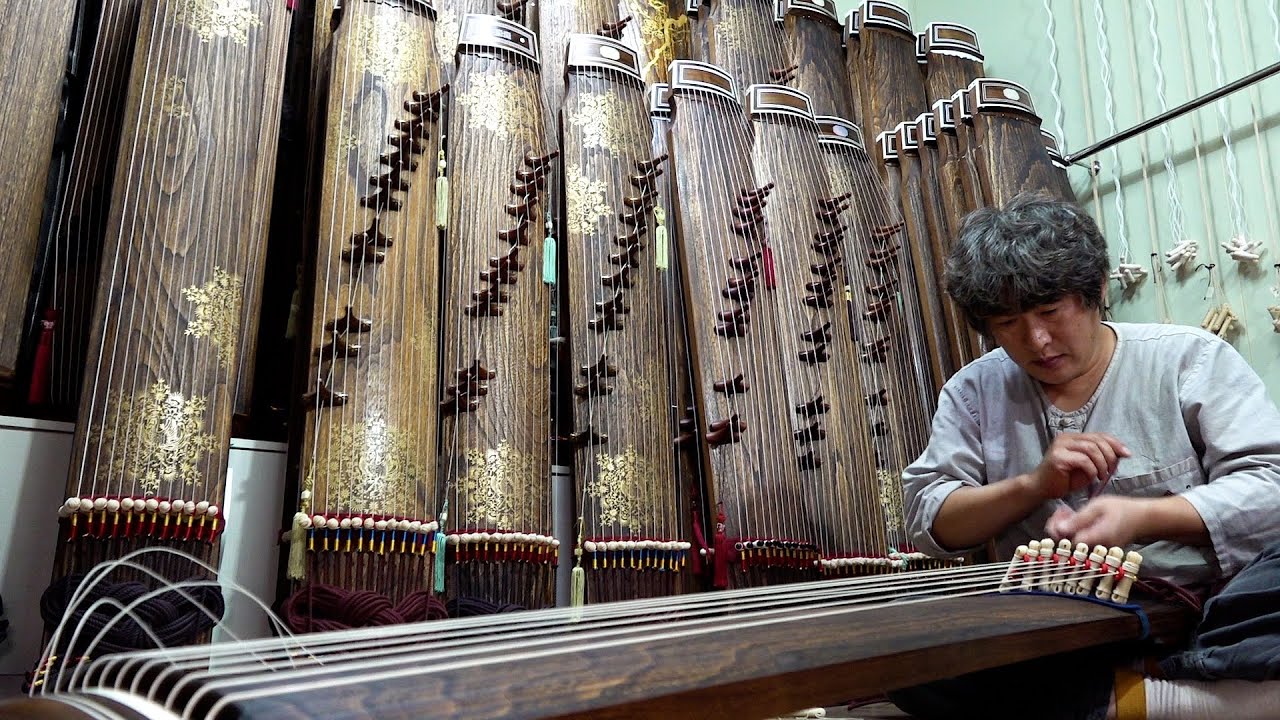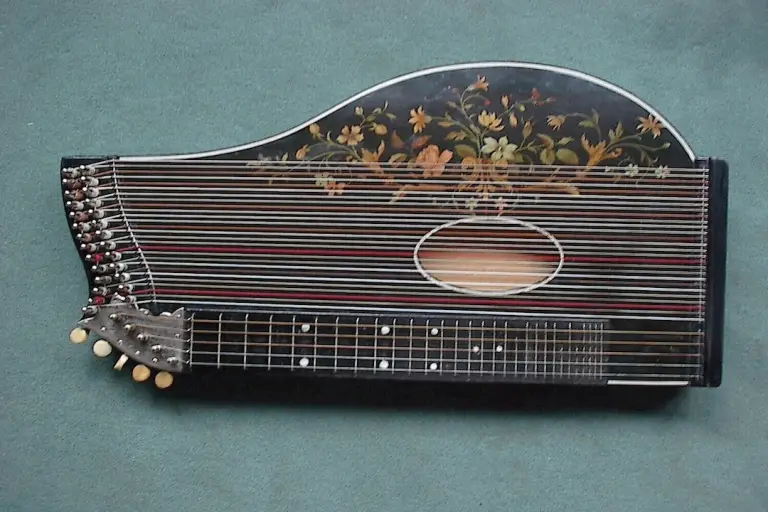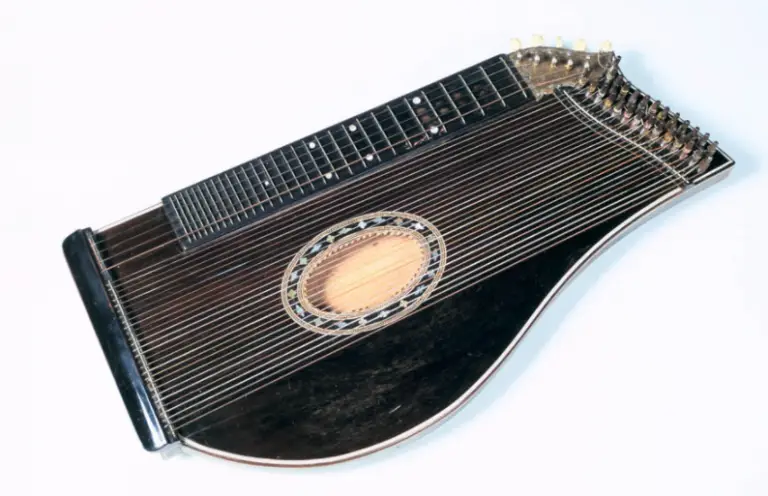How to Tune a Zither: Quick Guide for Beginners
Folkstrings.com is reader-supported. When you buy through links on our site, we may earn a small commission.
Tuning a zither is essential for ensuring the instrument produces the correct tones and harmonies, which is crucial for both practice and performance. As a stringed instrument with a heritage spanning various cultures, the zither has its own unique tuning process that can seem daunting to beginners.
My approach to tuning begins with familiarizing myself with the zither’s structure. The zither has multiple strings stretched across a wooden body.

To prepare for tuning, I ensure that my zither is placed on a flat surface and that I have a reliable tuning tool—commonly a tuning wrench or electronic tuner—ready for use.
I always check for any signs of damage on the strings or the body of the zither, as these can affect the tuning and sound quality.
I then proceed systematically, adjusting each string one by one according to the desired pitch. Consistency and patience are key, as each adjustment can affect the tension of other strings.
Key Points
- Tuning a zither is a vital step for accurate sound and involves adjusting string tension to achieve the desired pitch.
- Proper preparation, including a stable work surface and the right tools, is necessary for effective tuning.
- Regular tuning and maintenance can enhance one’s musical experience and prolong the lifespan of the zither.
Table of Contents
Let’s Look at the Basics of a Zither Instrument
Tuning a zither to achieve a harmonious sound requires insight into its various forms and structural intricacies. I’ll guide you through understanding the different types of zithers and their unique components.
Types of Zithers
Zithers come in multiple forms, each with distinct features and sound characteristics.
The concert zither is a popular choice, consisting of both melody and accompaniment strings, offering a full range of musical expression.
For those interested in chords, the chord zither is tailored with separate groups of strings for melody and chords.
Much like its name, the harp zither resembles a harp in appearance and sound, featuring a large number of strings.
- Concert Zither: Typically has 29 to 37 strings, with melody strings over a fretboard, and accompanying bass strings.
- Chord Zither: Features chords grouped together with additional melody strings, played without frets.
- Harp Zither: Similar to a concert zither but arranged like a harp, allowing for expansive musical pieces.
Anatomy of a Zither
Understanding the anatomy of a zither is key to mastering its tuning:
- Fretboard: Found on the concert zither, the fretboard allows for precise play of melody notes.
- Bass Strings: These strings provide the zither’s lower notes and are often tuned to a chromatic scale.
- Accompaniment Strings: Surrounding the bass strings, these strings are played open-handed and are essential for harmony.
- Tuning Pins: Used to adjust the tension of strings, affecting the pitch; proper tuning is essential.
- Bridge: The point of contact for strings, crucial for the transfer of vibrations and thus the sound produced.
By focusing on these varied aspects, I ensure my zither is perfectly tuned for melodic and harmonic balance.
Preparing to Tune Your Zither
Before I start tuning my zither, I like to ensure I have all the necessary tools at hand and understand which strings correspond to which notes. This preparation makes the tuning process smoother and more accurate.
Gather Necessary Tuning Tools
For my zither tuning session, I gather the following tools:
- Tuning Fork: A standard A (440 Hz) tuning fork is essential for establishing a reference pitch.
- Electronic Tuner: I find a chromatic digital tuner invaluable for precise tuning, especially for the zither’s numerous strings.
- Piano (Optional): If available, a properly tuned piano can serve as an excellent reference for tuning your zither strings.
Identifying Strings and Notes
My zither consists of several strings that need to be tuned to specific notes. Here’s how I identify them:
Open Strings Tuning for Zither
| String Group | Note | Frequency |
|---|---|---|
| Bass strings | G | 196 Hz |
| Contrabass strings | C | 65.41 Hz |
- I start by identifying the open strings which are typically the melody strings – commonly tuned to G, D, A, E, and F.
- Then, I shift my attention to the bass and contrabass strings, ensuring that the bass notes like G are tuned an octave below the melody strings.
Using an electronic tuner, I can easily identify each string and its current pitch. This helps me systematically approach tuning each string, from the lower bass notes to the higher treble notes.
Remember, maintaining a friendly relationship with your tools and instrument makes the task not just necessary, but also enjoyable.
Tuning Your Zither Step by Step
Tuning a zither can be a rewarding process as it brings out the instrument’s delightful harmonies. I’ll guide you through tuning both the melody and accompaniment strings, using a mix of traditional methods and modern tools.
Tuning Melody Strings
The melody strings of a zither are typically tuned chromatically. I start by setting my reference pitch using a tuning fork or digital tuner.
Let’s say I’m tuning to standard concert pitch, which is A440 Hz. I’ll use the digital tuner to ensure my A string is perfectly in tune.
From there, I tune each adjacent string using the chromatic sequence (C, D, E, F, G, A, B):
- Begin with the A string and move to the B string, checking each pitch with the tuner.
- Progress chromatically downwards to G, F, E, D, and C.
- Remember, temperature changes can affect tuning, so I always tune in a stable environment.
Hint: Pluck the string gently for a clear tone and an accurate reading on your tuner.
Tuning Accompaniment and Bass Strings
Accompaniment strings add depth to the zither’s sound. These strings are tuned to specific chords.
For my zither, I follow the open string method for a C major tuning:
- Organize strings into groups based on the chord they form—C, G, or F.
- Tune the root note of each group first (C for the C group, G for the G group, etc.).
- Complete the chord by tuning the third and fifth notes.
The bass strings or contra bass strings are the foundation of the zither’s harmony. I tune these strings starting with the lowest C and ascending chromatically.
An electronic tuner greatly simplifies this process, as accurate pitch recognition for these lower tones can be challenging.
Fine-Tuning for Perfect Harmony
After all strings are closely tuned:
- I play chords to check for harmony. Discrepancies are more evident this way.
- Fine adjustments are made to the tuning pegs until the strings resonate without dissonance.
- My final step is to recheck the open strings and make minute corrections if needed.
Fine-tuning takes a patient ear and a delicate touch. With all strings in unity, my zither is ready to produce the enchanting sound it’s known for.
Caring for Your Zither
To ensure your zither produces the best sound and stays in tune, regular maintenance and understanding how temperature and humidity affect the wood and strings are key.
Regular Maintenance
I make it a habit to check my zither’s strings and wooden components regularly. Here’s what I focus on:
- Strings: I check for rust and wear, especially on the thinner strings which are more prone to breakage. If they’re looking worn, I replace them promptly.
- Tuning Pegs: I ensure they are tight enough to hold the tune but not so tight that they damage the strings.
- Soundboard and Body: I inspect the wood for any cracks or warping which can affect the sound quality.
I keep a maintenance schedule like so:
| Frequency | Task |
|---|---|
| Daily | Wiping down strings |
| Weekly | Checking for string wear |
| Monthly | Detailed wood inspection |
| Semi-annually | Professional check-up |
Dealing with Temperature and Humidity
My zither is made of wood, making it sensitive to temperature and humidity. I use the following guidelines to protect it:
- Avoid Extremes: I keep my zither away from direct sunlight and radiators to prevent the wood from warping.
- Control Humidity: I use a dehumidifier in damp environments and a humidifier in dry climates to keep the humidity level around my zither consistent.
Mastering the Art of Playing the Zither
As we embark on the journey of mastering the zither, I’ll share insights into the foundational techniques, advanced skills to aspire to, and resources to support your growth. Let’s begin with the basics.
Basic Playing Techniques
When I first started playing the zither, I focused on basic playing techniques.
Positioning the zither properly is crucial, as is learning to pluck the strings with precision.
The right hand often plays the melodies, similar to how a violin sings out its notes. At the same time, the left hand must become adept at creating harmonious chords, an accompaniment that supports the tune, much like the rhythm guitar does in a band.
- Finger Placement: Ensure your fingers are arched and striking the correct strings with the fingertips.
- Strumming and Plucking: Start with simple strums using a zither plectrum before moving on to individual string pluckings.
Advanced Playing Techniques
Once comfortable with the basics, I aimed to master advanced techniques to enrich my playing.
This included experimenting with varied tempos, incorporating more complex chords, and even exploring the different timbres the zither offers, akin to blending the harmonic range of a harp.
- Complex Chords: Practice transitioning smoothly between complex chord structures using the left hand.
- Dynamic Expression: Work on varying the intensity of your playing to add an emotional dimension to the music.
Finding Learning Resources
I cannot understate the importance of using learning resources to master the zither.
- Online Tutorials: Look for YouTube channels with step-by-step guides.
- Community Forums: Find a community of fellow zither enthusiasts for shared tips and encouragement.
- Professional Instruction: If possible, learn from an instructor to receive personalized guidance and critiques.
Frequently Asked Questions
In this section, I’ll address some common questions to help beginners get their zither in tune and ready to play.
What are the steps to properly tune a zither for beginners?
First, ensure each string is at the correct pitch by using an electronic tuner or tuning fork.
Start with the lowest note and work your way up. Then, tighten or loosen the tuning pins using a tuning wrench.
Can you provide a beginner’s guide to 15-string zither tuning?
Yes, for a 15-string zither, typically, you will tune the strings diatonically like the white keys on a piano.
Use a chromatic tuner and begin from the lowest string, usually C, and move up to the highest, usually C two octaves higher.
What tools do I need to accurately tune my lap harp?
You will require a tuning wrench for the pins and an electronic tuner or a tuning app on your phone to ensure each note is precisely in tune.
What is the standard tuning for a zither?
Standard tuning will vary depending on the type of zither, but a common setup for a concert zither is from a G3 to a G7 including chromatic notes. Always check your specific zither’s tuning chart.
How do you adjust a zither to play chords in tune?
To adjust the zither for chords, you need to fine-tune the strings that form the chord.
Check the tuning in the context of the chord, and make small adjustments to the tuning pins as needed for harmony.
What is the proper way to use a tuning chart for a zither?
A tuning chart shows you the note each string should be tuned to. Match the string number on your zither to the note on the chart.
Then, use your tuner to adjust the pin until the string sings the correct note.
Author Profile
-
Daniel Johnstone is an English writer with a love for stringed instruments from around the world.
He shares his love for these instruments through his writing for folkstrings.com, a website dedicated to all things related to folk string music.
Daniel's passion for music started at a young age, and he has since become an accomplished musician, playing guitar, cavaco, and recently, the harp.
His dedication to learning and sharing his knowledge of stringed instruments is evident in his insightful and engaging blog posts. Whether you're a seasoned musician or a beginner, Daniel's writing is sure to inspire and entertain you.
When he's not playing music or writing, you can find Daniel exploring new instruments and seeking out new sounds to share with his readers.
Latest entries
 AutoharpApril 4, 2024What Is the Autoharp Made Of: Exploring Its Materials and Craftsmanship
AutoharpApril 4, 2024What Is the Autoharp Made Of: Exploring Its Materials and Craftsmanship AutoharpApril 4, 2024Is Autoharp Easy to Play? Unveiling the Truth for Beginners
AutoharpApril 4, 2024Is Autoharp Easy to Play? Unveiling the Truth for Beginners AutoharpApril 4, 2024What Is an Autoharp Worth? Your Guide to Pricing and Value
AutoharpApril 4, 2024What Is an Autoharp Worth? Your Guide to Pricing and Value AutoharpApril 4, 2024Are Autoharp and Zither the Same Thing? Unraveling String Instrument Myths
AutoharpApril 4, 2024Are Autoharp and Zither the Same Thing? Unraveling String Instrument Myths
Affiliates:
This post may contain affiliate links that at no additional cost to you, the site may earn a small commission. We only recommend products we would use ourselves and all opinions expressed on this site are our own.
Accuracy Advice:
While we strive to provide up-to-date and accurate information, the content in this article may not reflect the most current research or medical guidelines. We encourage readers to do further research and consult with professionals for more personalized advice.
Our Recommendations:
The products and services mentioned in any of our articles are recommended based on our independent research and personal experience. We are not sponsored by any company. We aim to suggest products and services we believe are of high quality and could be beneficial to our readers.






